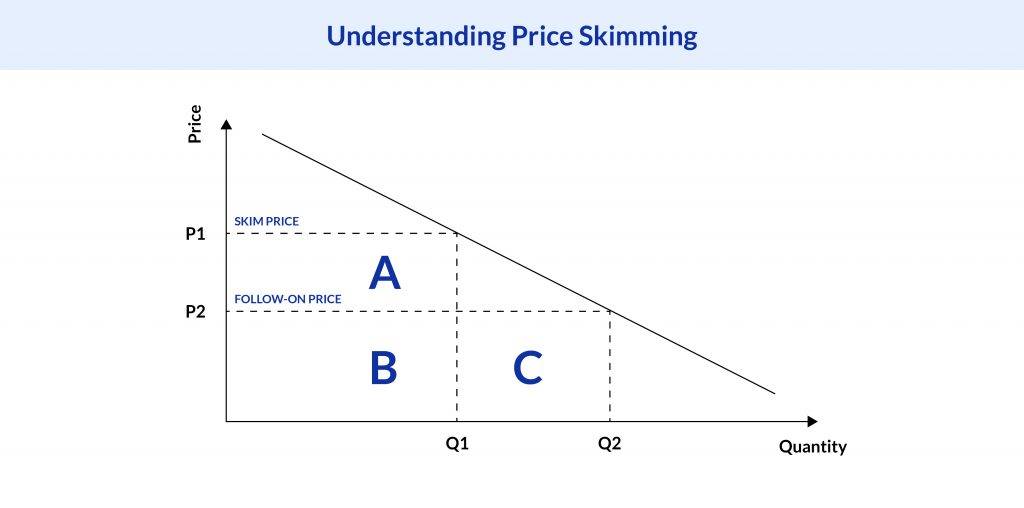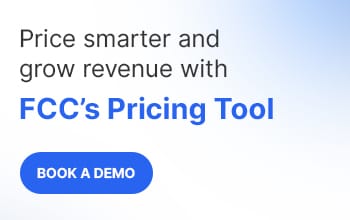Table of Contents
- What is price skimming?
- How does price skimming work?
- Advantages of price skimming
- Disadvantages of price skimming
- What are the alternatives to price skimming?
- What is the difference between price skimming and penetration pricing?
- Summary
What is price skimming?
Price skimming strategy is a strategic approach to product pricing where a business begins by setting the highest price for a novel product, aiming at early adopters who are prepared to pay a premium. As the initial wave of customers is catered to and as rival products emerge, the business reduces its prices to appeal to a more cost-conscious demographic. This strategy is commonly employed when a new product or new technologies are introduced to the market. The objective is to maximize revenue while consumer demand is high and before competition intensifies.
Products with a high perceived value or unique attributes are well-suited for this approach, as early adopters are typically less price-sensitive. By initially focusing on these consumers, businesses can recoup their development costs swiftly and realize substantial profits early on. As more competitors enter the market, reducing the price of the product assists in reaching a wider audience and preserving market share.
How price skimming works?
The rationale behind skim pricing lies in its ability to secure maximum revenue in the early stages of a product’s life cycle. Initially, the highest price targets early adopters who perceive the product as high quality, high status, innovative, or otherwise superior to other products. This perception creates high consumer demand among customers who are willing to pay more for these perceived benefits.
For instance, consider a technology company launching a new, innovative gadget. The initial high price targets loyal customers and tech enthusiasts who are less sensitive to price and are willing to pay a premium to own the exclusive product first. This strategy allows the company to recoup their development costs swiftly and realize substantial profits early on.
As the initial wave of customers is catered to and as rival products emerge, the company reduces its prices to appeal to a more cost-conscious demographic. This gradual reduction in price helps the company reach different layers of consumers over time. For example, once the initial hype around the new gadget subsides and similar products enter the market, the company can lower the selling price to make the product more accessible to a broader audience.
However, it is important to note that a skimming pricing strategy is not generally considered a long-term pricing strategy due to rival products entering the market. It’s a strategic approach that works best for products with a high perceived value or innovative features, where early adopters are less sensitive to price.

Advantages of price skimming
Here are some of the key benefits of the price skimming model:
- Accelerated Recovery of Fixed Costs: The expenses associated with developing new products, marketing them, and acquiring customers can be substantial, leading to extended payback periods. By securing early customers at a higher price point, you can expedite the recoupment of these significant R&D costs.
- Brand Image Enhancement: Price skimming can also serve as a marketing tactic. By initially setting a higher price for your product or service, you can cultivate an image of superior quality.
- Market Segmentation: Identifying customers who are willing to pay a premium to access your product or service first allows you to segment your customer base. This segmentation can be beneficial for future marketing and sales initiatives.
- Product Testing by Early Adopters: The initial high prices can be useful to ensure a balance between the need for real users to test your products and the risk of being overwhelmed before your product evolves into a robust offering. For instance, a high-end electronics retailer might use this strategy when launching a new, innovative gadget. The early adopters, who are less price-sensitive, provide valuable feedback that helps the retailer refine the product before it’s introduced to a broader, more price-conscious audience.
Disadvantages of price skimming
While price skimming has its benefits, it’s important to consider the potential drawbacks of this type of pricing strategy as well. Here are some of the key disadvantages:
- Inelastic Demand Requirement: Price skimming is effective when the demand for your product is inelastic, i.e., the demand doesn’t fluctuate significantly with price changes. If your product’s demand is elastic, high initial prices could negatively impact sales volume.
- Challenges in a Crowded Market: In a saturated market, high launch prices can deter customers. Unless your product offers unmatched innovative features, price skimming may not be the best strategy to maintain a competitive edge.
- Attracting Competitors: High initial prices can draw competitors’ attention. This could lead to a reduction in the inelasticity of your product’s demand curve over time as substitutes become available.
- Risk of Alienating Early Adopters: Early adopters who paid the initial high prices may feel disgruntled if prices drop significantly or too soon after the product launch. This could potentially trigger a PR crisis.
What are the alternatives to price skimming?
There are several alternatives to price skimming that businesses in the retail sector can consider:
- Competitive Pricing: This strategy involves pricing products or services in line with competitors’ prices. Competitive pricing is a common approach in markets where similar products are available from multiple retailers.
- Value-Based Pricing: This strategy sets prices based on the perceived value of the product for the user. It is often used for products or services that offer unique benefits or features that customers highly value.
- Dynamic Pricing: This strategy adjusts prices in response to market conditions. It is commonly used in online retail, where prices real-time price adjustment is possible based on factors like demand, inventory levels, and customer behavior.
- Penetration Pricing: This strategy sets a low initial price to quickly gain market share. It’s typically used when entering a competitive market, with the aim of attracting customers away from established brands by offering lower prices.
What is the difference between price skimming and penetration pricing?
Price skimming and penetration pricing are contrasting strategies. Price skimming employs high initial prices to earn as much revenue as possible with successful product launches, while penetration pricing utilizes low initial prices to boost sales volume.
Price skimming is ideally suited for unique or novel products, whereas penetration pricing is most effective in an intensely competitive market where brand loyalty is prevalent among customers.
Both strategies are typically employed as short-term tactics. Extended use of penetration pricing could result in lower revenue per customer, while prolonged use of price skimming may invite competitors who believe they can offer more competitive pricing.
Summary
Price skimming involves setting high initial prices for novel products to attract early adopters, subsequently reducing prices to appeal to more cost-sensitive consumers. This strategy optimizes early revenue and aids in recovering development expenses. However, the timing of price reductions is crucial; for instance, postponing price reductions could potentially steer customers towards competitors.
While price skimming can be effective, it is most successful for highly innovative products or those with a high perceived value. It tends to be less effective for products introduced by competitors following the original product launch, as the early adopter market may already be saturated.
FAQ
Price skimming is a strategic approach to pricing where a business introduces a product at a high price. The goal here is to target those consumers who are willing to pay a premium for its novelty or unique features. As the product becomes more commonplace and competitors emerge, the business reduces the price to attract a wider, more price-sensitive audience.
No, price skimming is not illegal. It is a legitimate retail pricing strategy used by many businesses. However, it’s important to note that the success of this strategy hinges on its correct implementation. If not executed properly, it can potentially harm a company’s reputation. The key to this strategy is to appropriately price the product at launch and then time the price reduction correctly. When done right, it can maximize revenue without alienating customers.
Nike uses this price skimming for its limited-edition collections like Air Jordans, which are launched at premium prices. This approach is focused on consumers who are willing to pay high prices for exclusive designs, allowing Nike to maximize revenue during the initial phase. Over time, the prices of these special collections are reduced to attract a broader customer base.
Price skimming is widely used across various industries, including high-end fashion brands, premium electronics manufacturers, such as the latest OLED TV models, and smartphone providers.

